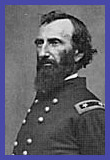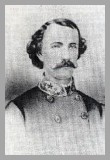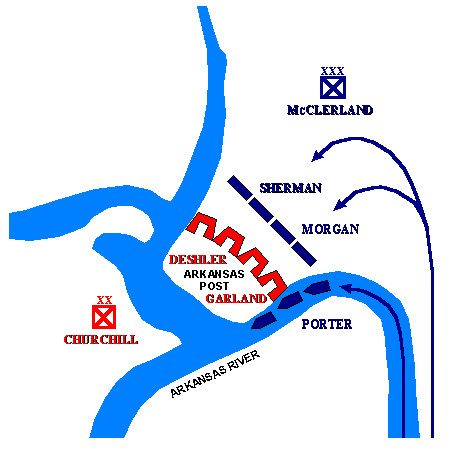THE BATTLE OF
Arkansas Post
(9 - 11 January 1863)
"Glorious! Glorious! ... My star is ever on the ascent."
-- Major General John A. McClerland, following the Battle of Arkansas Post, January 1863.
"General McClerland has fallen back to the White River, and gone on a wild-goose chase to the Post of Arkansas."
-- Lieutenant General Ulysses S. Grant, dispatch to Halleck, January 1863.
Principal Commanders
Union:
Major General John A. McClerland
Major General William T. Sherman
Major General George W. Morgan
Rear Admiral David A. Porter
| |
Confederate:
Brigadier General Thomas J. Churchill
Colonel James Deshler
Colonel Robert Garland
|
| |

McClerland |

Sherman |
|

Churchill |

Morgan |
Physical Features
In 1686, the trading post known as Poste de Arkansea was built by the French. It was the first semi-permanent settlement in the lower Mississippi River Valley and it opened a long struggle between France, Spain, and England over control of interior North America. In 1803, Arkansas Post became part of the United States through the Louisiana Purchase, and by 1819, it was a thriving river port. The largest city in the Arkansas Territory, it became its capitol ... until January of 1862.
In 1862, Confederates constructed an earthen fortification near Arkansas Post known as Fort Hindman. It was a square bastion on high ground at the head of a horseshoe bend in the Arkansas River. Fort Hindman commanded a dozen guns, including three nine-inch Columbiads. Most of the Confederate infantry were in rifle pits a mile and a half in front of the fort, supported by six field artillery. An impassable swamp extended one mile west of the fortification. There were only 4,800 Confederate soliders manning the fort. Coming their way were 30,000 Union infantry aboard a naval flotilla that included fifty troop transports, three ironclads, and ten rams and gunoats.
Description of the Battle
On 8 Janurary 1861, the flotilla passed the mouth of the Arkansas, seemingly headed back to Memphis. But it was a deception, for they turned up the White River and crossed back to the Arkansas River by way of a cutoff. On the evening of 9 January, they anchored three miles below Fort Hindman, at which time division commanders Major General William T. Sherman and Major General George W. Morgan disembarked and began to move overland to position themselves before the fort. Meanwhile, Rear Admiral David D. Porter closed on it with his gunboats.
The next morning the ironclads lead the bombardment. The Lousiville, De Kalb, and Cincinatti moved to within four hundred yards of the fort and began firing. The Confederate defenders resisted heavily, placing eight nine-inch shells into the Cincinatti pilot house alone. Only darkness halted the engagement. The night passed as Sherman and Morgan moved their troops into position and the rebels readied to meet the assault.
Shortly before noon on 11 January, Sherman and Morgan were in position. Porter had moved past the fort to prevent a Confederate retreat, and re-opened his bombardment that darkness had halted the previous day. It was the signal for Sherman and Morgan to move forward, which they did. But before the ground troops were able to approach the lines, the Confederates hoisted white flags of surrender.
Yet there was confusion in the Confederate command. Colonel John Dunning was in command of the fort and wanted to surrender to Porter. Colonel Robert Garland agreed and raised the surrender flags without bothering to check with his commanding officer. Brigadier General Thomas J. Churchill, in command of the ground forces, had been ordered to hold out at all cost. But the order that he had been given was issued without realizing the Union would devote so much manpower to such a trivial enterprise. Regardless, he did not wish to surrender, nor did Colonel James Deshler. They argued about who had hoisted the white flags as Union troops poured over the battlements. They were still arguing when Sherman approached them. Deshler told Sherman he was not willing to surrender, but Sherman pointed out his men were already disarmed. There was nothing either commander could do but reluctantly surrender against their will to superior numbers.
Results
- Union victory.
- The successful attack on Arkansas Post netted the Union forces 5,500 Confederate prisoners.
- The actual site of the trading post had moved many times during its history due to flooding by the Arkansas River. But it would be the bombardment that would end its existence. For the Union forces not only destroyed the fort, but the adjacent river port town in order to ensure control of the Arkansas River.
Statistics
| Army | Arkansas Post
|
|---|
| Effectives | Casualties |
|---|
| Union |
30,000 |
1,047 |
| Confederate |
4,800 |
109 |
| Total |
34,800 |
1,156 |
Additional notes, interesting incidents, and fate of the principals
- The battle of Arkansas Post was a lopsided victory, almost not worthy of press. Grant saw it as a wild-goose chase and so informed Washington when he received the dispatch from McClerland that outlined his intentions. Halleck informed Grant that he was to relieve McClerland from command. But it came to late. By the time Grant received the communication from Washington, Arkansas Post had already been taken. Removing McClerland now would look like an attack on a public hero, no matter how trivial the victory. In addition, Grant leaned the plan of attack had originated with his friend Sherman. All Grant could do was wait for another opportunity to remove McClerland. It would come soon.
- Grant detested McClerland, and the rivalry continued. But while attacking Vicksburg the second time, McClerland sent an overly bombastic congratulatory order to his men without sending it first through Grant. When Vicksburg fell, Grant relieved him of his command. McClerland received another command in time for the Red River Campaign, but he damaged his reputation and become so seriously ill he had to resign his commision. He would never become the serious contender for the White House that he had imagined. In a twist of irony, it was Grant who's star was on the rise and who would eventually reach the Presidency. When he did, he made his good friend Sherman General-in-Chief of the Army.
- The two Confederate commanders that surrendered against their will -- Churchill and Deshler -- walked very different paths. Churchill had established himself as one of the more competent commanders in the western theatre of the war. He was exchanged in time to command a division in General Edmund Kirby Smith's Department of Trans-Mississippi that was predominantly successful throughout the remainder of the war, and was the last department to surrender. Conversely, Deshler never really got on track with his Civil War military career. Early on he was wounded at the Battle of Allegheny Summit in western Virginia while serving under Brigadier General William H. Jackson. When he recovered from his wounds he had been assigned to the unmotivated Theophilus H. Holmes. After Holmes' poor performance at the Battle of Malvern Hill, Deshler was reassigned to the hapless Arkansas Post, and captured. After his release he was finally assigned to arguably the best division commander in the west, Major General Patrick Cleburne. But once again fate delt him a loosing hand. Just before a Battle of Chickamauga -- a battle that would become the Army of Tennessee's greatest success -- an artillery round dropped into his Confederate line and killed him.
Sources:
- Faust, Patricia, L., ed. Historical Times Illustrated Encyclopedia of the Civil War. 1986.
- Foote, Shelby. The Civil War, A Narrative. 1986.
- Long, E.B., and Long, Barabara, eds. The Civil War Day by Day. 1971.
- McPherson, James M., ed. The Atlas of the Civil War. 1994.
On the Internet:
- Arkansas Post National Memorial
 |
Return to
Vicksburg |





